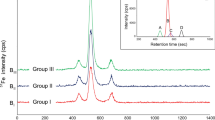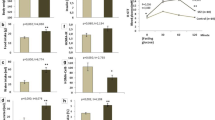Abstract
A noticeable effect of sulfite treatment was observed on the plasma ceruloplasmin ferroxidase activity of rats with normal sulfite oxidase activity when compared to normal controls. The plasma levels of selenium, iron, and zinc were unaffected by sulfite in normal and sulfite oxidase (SOX)-deficient rats. While plasma level of Mn was decreasing, plasma Cu level increased in SOX-deficient rats. Treating SOX-deficient groups with sulfite did not alter plasma level of Mn but made plasma level of Cu back to its normal level. This is the first evidence that Cu and Mn status were affected in experimental sulfite oxidase deficiency induced by low molybdenum diet with tungsten addition deserving further research to determine the underlying mechanisms of these observations in experimental sulfite oxidase deficiency.
Similar content being viewed by others
References
Lester MR (1995) Sulfite sensitivity: significance in human health. J Am Coll Nutr 14:229–232
Komarnisky LA, Christopherson RJ, Basu TK (2003) Sulfur: its clinical and toxicologic aspects. Nutrition 19:54–61
Dalton-Bunnow MF (1985) Review of sulfite sensitivity. Am J Hosp Pharm 42:2220–2226
Mitsuhashi H, Nojima Y, Tanaka T, Ueki K, Maezawa A, Yano S, Naruse T (1998) Sulfite is released by human neutrophils in response to stimulation with lipopolysaccharide. J Leukoc Biol 64:595–599
Hayatsu H, Miller RJ (1972) The cleavage of DNA by the oxygen-dependent reaction of bisulfite. Biochem Biophys Res Commun 46:120–124
Rencuzogullari E, Ila HB, Kayraldiz A, Topaktas M (2001) Chromosome aberrations and sister chromatid exchanges in cultured human lymphocytes treated with sodium metabisulfite, a food preservative. Mutat Res 490:107–112
Cohen HJ, Fridovich I (1971) Hepatic sulfite oxidase. Purification and properties. J Biol Chem 246:359–366
Mudd SH, Irreverre F, Laster L (1967) Sulfite oxidase deficiency in man: demonstration of the enzymatic defect. Science 156:1599–1602
Johnson JL, Rajagopalan KV (1976) Purification and properties of sulfite oxidase from human liver. J Clin Invest 58:543–550
Johnson JL, Rajagopalan KV, Cohen HJ (1974) Molecular basis of the biological function of molybdenum. Effect of tungsten on xanthine oxidase and sulfite oxidase in the rat. J Biol Chem 249:859–866
Dulak L, Chiang G, Gunnison AF (1984) A sulphite oxidase-deficient rat model: Reproductive toxicology of sulphite in the female. Food Chem Toxicol 22:599–607
Kajiyama H, Murase K, Miyazaki T, Isomoto H, Fukuda Y, Yamazawa N, Soda H, Takeshima F, Mizuta Y, Murata I, Kohno S (2001) Micronutrient status and glutathione peroxidase in bedridden patients on tube feeding. J Int Med Res 29:181–188
Baumgartner TG (1993) Trace elements in clinical nutrition. Nutr Clin Pract 8:251–263
Kirkbright GE (1980) Atomic absorbtion spectroscopy in elemental analysis of biological materials. Vienna Technical Report Series. Int At Energy Agency 197:141–165
Brodie KG, Routh MW (1984) Trace analysis of lead in blood, aluminium and manganese in serum and chromium in urine by graphite furnace atomic absorption spectrometry. Clin Biochem 17:19–26
Milde D, Novak O, Stuzka V, Vyslouzil K, Machacek J (2001) Serum levels of selenium, manganese, copper and iron in colorectal cancer patients. Biol Trace Element Res 79:107–120
Erel O (1998) Automated measurement of serum ferroxidase activity. Clin Chem 44:2313–2319
Gunnison AF, Sellakumar A, Currie D, Snyder EA (1987) Distribution, metabolism and toxicity of inhaled sulfur dioxide and endogenously generated sulfite in the respiratory tract of normal and sulfite oxidase-deficient rats. J Toxicol Environ Health 21:141–162
Kucukatay V, Agar A, Yargicoglu P, Gumuslu S, Aktekin B (2003) Changes in somatosensory evoked potentials, lipid peroxidation, and antioxidant enzymes in experimental diabetes: effect of sulfur dioxide. Arch Environ Health 58:14–22
Abedinzadeh Z (2001) Sulfur-centered reactive intermediates derived from the oxidation of sulfur compounds of biological interest. Can J Physiol Pharmacol 79:166–70
Kucukatay V, Hacioglu G, Savcioglu F, Yargicoglu P, Agar A (2006) Visual evoked potentials in normal and sulfite oxidase deficient rats exposed to ingested sulfite. Neurotoxicology 27:93–100
Tejnorova I (1978) Sulfite oxidase activity in liver and kidney tissue in five laboratory animal species. Toxicol Appl Pharmacol 44:251–256
Gunnison AF, Jacobsen DW (1987) Sulfite hypersensitivity, a critical review. CRC Crit Rev Toxicol 17:185–214
Cooper AJ (1983) Biochemistry of sulfur-containing amino acids. Annu Rev Biochem 52:187–222
Leung KH, Post GB, Menzel DB (1985) Glutathione S-sulfonate, a sulfur dioxide metabolite, as a competitive inhibitor of glutathione S-transferase, and its reduction by glutathione reductase. Toxicol Appl Pharmacol 77:388–394
Keller DA, Menzel DB (1989) Effects of sulfite on glutathione S-sulfonate and the glutathione status of lung cells. Chem Biol Interact 70:145–156
Houwen R, Dijkstra M, Kuipers F, Smit EP, Havinga R, Vonk RJ (1990) Two pathways for biliary copper excretion in the rat. The role of glutathione. Biochem Pharmacol 39:1039–1044
Ferreira AM, Ciriolo MR, Marcocci L, Rotilio G (1993) Copper (I. transfer into metallothionein mediated by glutathione. Biochem J 292:673–676
Yamaguchi Y, Heiny ME, Gitlin JD (1993) Isolation and characterization of a human liver cDNA as a candidate gene for Wilson disease. Biochem Biophys Res Commun 197:271–277
Hung IH, Suzuki M, Yamaguchi Y, Yuan DS, Klausner RD, Gitlin JD (1997) Biochemical characterization of the Wilson disease protein and functional expression in the yeast Saccharomyces cerevisiae. J Biol Chem 272:21461–21466
Vincent AS, Lim BG, Tan J, Whiteman M, Cheung NS, Halliwell B, Wong KP (2004) Sulfite-mediated oxidative stress in kidney cells. Kidney Int 65:393–402
Bakels RH, Van Wielink JE, Krab K, Van Walraven HS (1996) The effect of sulfite on the ATP hydrolysis and synthesis activities in chloroplasts and cyanobacterial membrane vesicles can be explained by competition with phosphate. Arch Biochem Biophys 332:170–174
Prohaska JR, Gybina AA (2004) Intracellular copper transport in mammals. J Nutr 134:1003–1006
Milne DB (1994) Assessment of copper nutritional status. Clin Chem 40:1479–1484
Calabrese E, Sacco C, Moore G, DiNardi S (1981) Sulfite oxidase deficiency: A high risk factor in SO2, sulfite and bisulfite toxicity. Med Hypotheses 7:133–145
Skornik WA, Brain JD (1990) Effect of sulfur dioxide on pulmonary macrophage endocytosis at rest and during exercise. Am Rev Resp Dis 42:655–659
Chamulitrat W (1999) Activation of the superoxide-generating NADPH oxidase of intestinal lymphocytes produces highly reactive free radicals from sulfite. Free Radic Biol Med 27:411–421
Izgut-Uysal VN, Kucukatay V, Bulbul M, Tan R, Yargicoglu P, Agar A (2005) Effect of sulfite on macrophage functions of normal and sulfite oxidase-deficient rats. Food Chem Toxicol 43:599–605
Prohaska JR, Broderius M (2006) Plasma peptidylglycine alpha-amidating monooxygenase (PAM) and ceruloplasmin are affected by age and copper status in rats and mice. Comp Biochem Physiol B Biochem Mol Biol 143:360–366
Beck-Speier I, Dayal N, Maier KL (1998) Pro-inflammatory response of alveolar macrophages induced by sulphite: studies with lucigenin-dependent chemiluminescence. J Biolumin Chemilumin 13:91–99
Grundler W, Dirscherl P, Beck-Speier I, Beisher W, Stampfl A, Zimmermann I, Maier K (2000) Simultaneous recording of calcium transients and reactive oxygen intermediates of human polymorphonuclear granulocyte in response to formyl-Met-Leu-Phe and environmental agent sulfite. Cytometry 40:219–229
Gitlin JD, Schroeder JJ, Lee-Ambrose LM, Cousins RJ (1992) Mechanisms of caeruloplasmin biosynthesis in normal and copper-deficient rats. Biochem J 282:835–839
Leach RM, Lilburn MS (1978) Manganese metabolism and its function. World Rev Nutr Diet 32:123–134
Christianson DW (2005) Arginase: structure, mechanism, and physiological role in male and female sexual arousal. Acc Chem Res 38:191–201
Oberley LW (2005) Mechanism of the tumor suppressive effect of MnSOD overexpression. Biomed Pharmacother 59:143–148
Tageda A, Sotogaku N, Oku N (2002) Manganese influences the levels of neurotranmitters in synapses in the rat brain. Neuroscience 114:669–674
Tanner MS (1998) Role of copper in Indian childhood cirrhosis. Am J Clin Nutr 67(Suppl):1074S–1081S
Mercer JF (1998) Menkes syndrome and animal models. Am J Clin Nutr 67(Suppl):1022S–1028S
Kaler SG (1998) Diagnosis and therapy of Menkes syndrome, a genetic form of copper deficiency. Am J Clin Nutr 67(Suppl):1029S–1034S
McArdle HJ, Van den Berg GJ (1992) The accumulation of copper by microvillar vesicles isolated from human placenta. J Nutr 122:1260–1265
Garrett IR, Whitehouse MW (1987) Copper and inflammation. In: Howell JM, Gawthorne JM (eds) Copper in animals and man, vol 2. CRC Press, Boca Raton, FL, pp 107–122
Cosan TE, Demir TA, Yayla E, Cosan D, Berber A, Kaynak Z (2006) Trace minerals in experimental subarachnoid haemorrhage: zinc, copper and manganese levels in rat brain tissue, blood and urine. Acta Neurochir (Wien) 148:443–448
Acknowledgments
The authors thank the Pamukkale University Research Fund, which supported this research through Project Number 2004-TPF006.
Author information
Authors and Affiliations
Corresponding author
Rights and permissions
About this article
Cite this article
Herken, E.N., Kocamaz, E., Kucukatay, M.B. et al. Ceruloplasmin, Copper, Selenium, Iron, Zinc, and Manganese Levels in Normal and Sulfite Oxidase Deficient Rat Plasma: Effects of Sulfite Exposure. Biol Trace Elem Res 123, 202–210 (2008). https://doi.org/10.1007/s12011-008-8105-z
Received:
Revised:
Accepted:
Published:
Issue Date:
DOI: https://doi.org/10.1007/s12011-008-8105-z




